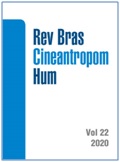Association between electromyographic localized muscle fatigue of the rectus femoris and static postural balance in physically active adult men
Resumen
Although the determinant impact of exercise-induced muscle fatigue prior to postural balance assessment has been widely described, recent evidence suggests that hyperventilation and sensorimotor losses, rather than muscle fatigue, are responsible for the changes observed in postural balance. However, the association between localized muscle fatigue (LMF), induced by isokinetic dynamometer protocol test and assessed through surface electromyography, and postural balance in adults is poorly understood. We aimed to evaluate the association between the LMF of the rectus femoris and static postural balance in 51 adult men (43±14.8 years; 26.9±5 kg/m2). We obtained physical activity level and postural balance, respectively, through a triaxial accelerometry and a force platform. The quadriceps femoris strength and endurance were obtained using an isokinetic dynamometer and surface electromyography simultaneously. The association between the isokinetic and electromyographic LMF and static postural balance was investigated using linear regression models adjusted for age, body mass index, and isokinetic quadriceps strength and LMF. The correlations between postural balance variables and isokinetic muscle strength and LMF were weak-to-moderate. After multivariate analyses, we observed that electromyographic LMF were a predictor of postural balance, mainly of the mean amplitude and COP area and velocity in the mediolateral direction, regardless of isokinetic variables. Therefore, LMF plays a determinant role in the postural balance of physically active adult men. Fatigue indices are significant predictors of postural balance, regardless of previous fatigue induction.
Citas
Bigland-Ritchie B, Rice CL, Garland SJ, Walsh ML. Task-dependent factors in fatigue of human voluntary contractions. Adv Exp Med Biol. 1995;384:361-80.
Chaffin DB. Localized muscle fatigue – definition and measurement. Journal of Occupational Medicine 1973;15:346-54.
Muehlbauer T, Gollhofer A, Granacher U. Associations Between Measures of Balance and Lower-Extremity Muscle Strength/Power in Healthy Individuals Across the Lifespan: A Systematic Review and Meta-Analysis. Sports Med. 2015;45:1671-92.
Hatton AL, Menant JC, Lord SR, Lo JC, Sturnieks DL. The effect of lower limb muscle fatigue on obstacle negotiation during walking in older adults. Gait Posture. 2013;37:506-10.
Papa EV, Garg H, Dibble LE. Acute effects of muscle fatigue on anticipatory and reactive postural control in older individuals: a systematic review of the evidence. J Geriatr Phys Ther. 2015;38:40-8.
Zemková E, Hamar D. Physiological mechanisms of post-exercise balance impairment. Sports Med. 2014;44:437-48.
Zemková E, Hamar D. Postural sway after exercise bouts eliciting the same heart rate with different energy yield from anaerobic glycolysis. Medicina Sportiva. 2003;7:135-9.
Kumar S, Fagarasanu M, Narayan Y, Prasad N. Measures of localized spinal muscle fatigue. Ergonomics. 2006;49:1092-110.
De Luca CJ. Myoelectrical manifestations of localized muscular fatigue in humans. Crit Rev Biomed Eng. 1984;11:251-79.
Garber CE, Blissmer B, Deschenes MR, Franklin BA, Lamonte MJ, Lee IM, et al. American College of Sports Medicine position stand. Quantity and quality of exercise for developing and maintaining cardiorespiratory, musculoskeletal, and neuromotor fitness in apparently healthy adults: guidance for prescribing exercise. Med Sci Sports Exerc. 2011;43:1334-59.
Troiano RP, Berrigan D, Dodd KW, Masse LC, Tilert T, McDowell M. Physical activity in the United States measured by accelerometer. Med Sci Sports Exerc. 2008;40:181-8.
Descargas
Publicado
Número
Sección
Licencia

Direitos Autorais para artigos publicados nesta revista são do autor, com direitos de primeira publicação para a revista. Em virtude da aparecerem nesta revista de acesso público, os artigos são de uso gratuito, com atribuições próprias, em aplicações educacionais e não-comerciais, desde que seja dada a atribuição. Esta obra foi licenciada com uma Licença Creative Commons Atribuição 4.0 Internacional - CC BY


